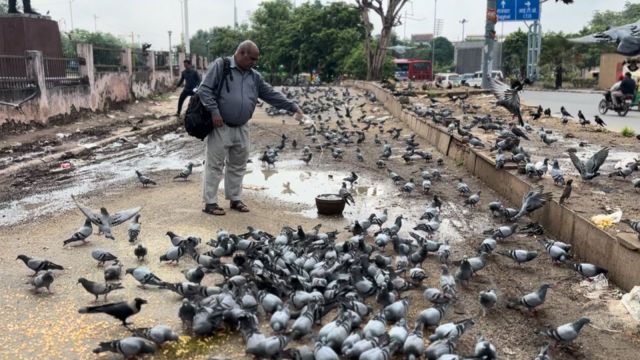‘When we feed someone, they bless us’: Faith vs health in Delhi’s pigeon feeding debate
From warning boards at popular feelings spots to health advisories, the Delhi civic body has been trying to control the Capital’s burgeoning pigeon population. Tradition and faith, however, mean that enforcement is tough.
 Pigeon feeding near Delhi Gate on Asaf Ali Road. (Express Photo)
Pigeon feeding near Delhi Gate on Asaf Ali Road. (Express Photo)At 9 am, Muhammad Yunus fixes his blue umbrella near Delhi Gate on Asaf Ali Road.
Methodically, he lays out plates filled with a spread of green and black gram, dried corn and namkeen. He then waits for customers — the dozens of people who stop at his roadside stall to feed pigeons.
“I sell roasted gram for Rs 10-20, depending on the demand. The Municipal Corporation of Delhi (MCD) has sent us challans, asking us to vacate the area,” says Yunus, who has been running his tiny stall at this spot for the last 15 years.
 Muhammad Yunus, near Delhi Gate on Asaf Ali Road. (Express Photo)
Muhammad Yunus, near Delhi Gate on Asaf Ali Road. (Express Photo)
Soon after, Sudha Pandey arrives with a Rs 10 note. She buys a cup of roasted gram for the birds. “I have been coming here for seven days now to pray for my husband who is admitted in the hospital. When we feed someone, they bless us,” she says.
In a letter dated July 8, the MCD’s health department asked the veterinary department to control the Capital’s burgeoning pigeon population. This followed warnings about pigeon faeces causing respiratory and fungal infections and the need to control their population.
The issue of the birds being a public menace and causing diseases also became a topic of discussion in the civic body’s Standing Committee in a meeting on June 27. Last year, the MCD had said that public feeding of pigeons, which leads to the population of the birds increasing beyond the carrying capacity of an area, would be checked.
In a similar move earlier this month, the Maharashtra government had directed the Brihanmumbai Municipal Corporation to close kabootar khanas or pigeon feeding spots in the city, citing serious health hazards due to pigeon droppings and feathers.
According to Dr Vikas Maurya, senior director and head of Pulmonology at Fortis Hospital in Shalimar Bagh, pigeon droppings are the root cause of many diseases in India. “These can cause fungal and bacterial diseases such as Campylobacter, allergic reactions such as sneezing, running nose, itching eyes as well as Hypersensitivity Pneumonitis, which can eventually cause lung fibrosis,” he says.
“Hawkers don’t even realise that being exposed to the birds for so long is harmful. The rampant increase in pigeon population needs to be controlled,” he adds.
Tradition and faith, however, mean that enforcement is tough.
“The civic body cannot completely ban pigeon feeding activities in Delhi. Also, as of now, we do not have any plan to construct designated pigeon feeding areas,” a senior MCD official says.
Over the past three months, however, the MCD has put up announcement boards at popular feeding spots to warn people.
The Indian Express visited some spots where bird feeders gather regularly.
Shastri Park
 Pigeon feeding near Shastri Park. (Express Photo)
Pigeon feeding near Shastri Park. (Express Photo)
Almost 20 km from Delhi Gate, MCD workers clean polythene bags with pigeon feed lying on the pavement at Shastri Park.
As vehicles pass by, dried pigeon excrement and loose feathers fly in the air. “We ask people not to feed birds here, but they don’t listen… They keep flocking to the area, pigeon feed in hand,” one of the MCD workers says.
The worker adds that occasionally, pigeons are captured and taken to a veterinary hospital in Teliwara Shahdara, where they are kept in a cage.
Rajghat
Ramjeet, who feeds pigeons everyday while on the way to his office near Rajghat, is unconcerned about the MCD’s directive. “If the MCD wants us to stop, they should build some designated feeding spots facilities. We will go there.”
The feeding spot he has chosen is in the central verge of two busy roads going towards ITO and ISBT Kashmere Gate. The pigeons flock to the centre of the large open space as soon as passersby stop to empty a sack of grain.
Two hawkers, who sell grains here, keep their ware hidden, as a nearby MCD board reads — ‘No Feeding Zone’.
Chittaranjan Park
For residents staying near Chittaranjan Park in Southeast Delhi, the pigeon feeding spot located near B Block has been a major cause of concern.
Feathers, dried faeces, grains, sometimes even dead birds, are routinely found at the spot. The feeders, they claim, pay no heed to traffic rules, parking their vehicles in the middle of the road – sometimes also in the wrong direction – to feed birds.
A resident of Nehru Apartments, Satish Kumar, says the birds fly low near the feeding spot, resulting in injuries to many motorists.
“We can’t walk around the feeding spot, it smells. The food that rots there has led to an increase in the rat population; the rodents sometimes enter our homes too… Moreover, pigeons build nests in our balconies, which are also full of dried faeces,” he adds.
Piyush Prasad, the RWA president of Nehru Apartments, says many pigeons die when vehicles hit them. “This has led to an increase in the feline population as well, since they feed on the carcass.”












